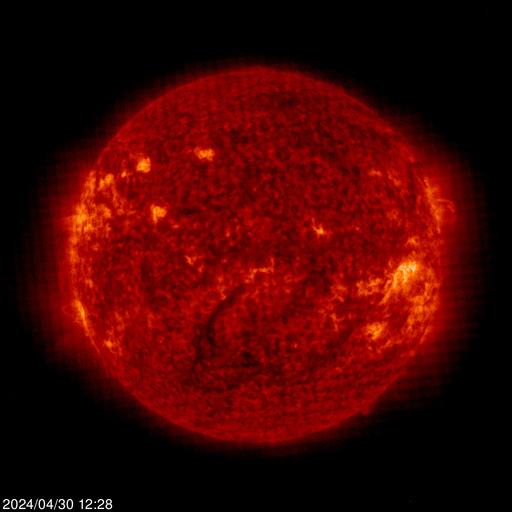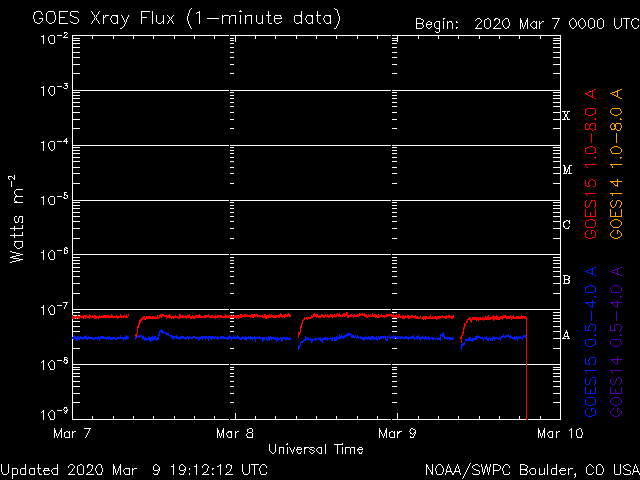Part 2: The Shot - Beginnings of a Solar Storm
First, consider finding the best range of information in one place
Most of the following information is available on one site. NASA provides a very comprehensive set of data including their very new 3D based animations of predicted events on their iNTEGRATED SPACE WEATHER ANALYSIS SYSTEM website here. But be warned! This is very indepth and will demand a lot of study for the novice.
Example frame from an animation derived from 3D modelling of the sun's heliosphere, showing the density of it's solar wind and other ejections - in this case a CME (Coronal Mass Ejection) from a M1-Class flare.
Watch for the solar flare
 |
| Over 140 explosion occurred during the Halloween Solar Storms 11 were X rated including the brightest yet. See the movie from SOHO/EIT and SOHO/LASCO. here |
| Credit - NASA/ESA, NASA/Goddard Space Flight Center Scientific Visualization Studio |
Thanks to many enthusiastic Aurora vigilantes and I can go about a normal life in ignorant bliss of the heavens, until the next burst of solar radiation. All I need is an Email from Noaa - totally reliable for alerts. Sign up for the email service here.
If you really don't want to miss out you can buy a service from Spaceweather Phone, and schedule when you would like to receive alerts.
If life is busy and some planning ahead helps then keeping an eye on forecasts may help. A strong sun spot may rotate back into view for a rerun. Here is a long term one (28 days) from the Geophysical Institute.
Once alerted it becomes a very different matter. Straight away, I need to know more about the nature of the event and local weather conditions, so I can form an opinion on my chances of seeing something and whether to drop all tools in a day or so allow it to overtake my life and cause great loss of sleep.
Watch the Watchers
{Update] Nasa's Space Weather Labority now has a supurb website iSWA combining many of the resources that follow into a single panel which users can configure for themselves.
[Update] Nasa's SDO (Solar Dynamics Observatory) has just been launched (February 2010) providing HD quality motion imagery of the sun. This mission wil further our understanding of the sun's influence on earth and for me, more certainty about when to look for auroras.
STERIO launched in 2006 is already giving me an incredibly better idea of the solar effects and I can't wait for the sun to liven up a bit to test how well this information helps with my sighting of auroras.
GOES 12 Solar X-ray Imager, launched in 2001, produces images of the sun at 1 minute intervals. Sitting over the equator near middle of the Pacific Ocean it also gains a clear view of this side of the Earth. But as it rotates in a stationary position above the Earth, its view of the sun is briefly blocked by the earth.

In 1995 SOHO (Solar & Heliospheric Observatory) was launched and this spacecraft now sits away out in space (about 1.5 million km from Earth and 148.5 million km from the Sun) where it is held in a tug-of-war between the Earth's and Sun's gravitational pull. Here it enjoys a less interrupted study of the sun. SOHO also has a very good space weather page.Then I like to know where on the sun the activity is coming from. Basically the more the activity is towards the middle of the sun the greater the chance of a blast (Coronal Mass Ejection - CME) heading directly our way. Otherwise we may get a glancing blow only.
 |
   |
This set of images from the sun are updated every minute and by pressing F5 this page will reload giving and almost instantaneous view. The bright area are the 'sun spots' and can vary depending on the sun level of activity.
I am happy to wait for these to flare up but if you want to know what the chances are, they are continually updated here.
Experts can tell by the configuration of sunspots how big likely flares might be. A really active one may fire off every day or two. They rotate with the sun coming into view on the eastern shoulder (left had side), turn full-on to us and exit to the right. The odd ones are so persistent that they revolve right round to let off another passing volley. increasing our chances of seeing aurora off and on over over a 'season' of a few weeks.
Once a big flare is underway I might get even more curious and look at SOLARSOFT for more information and even take a close up view of the flare in action.
Also it can be very interesting to take an even more detailed view of the action, marvel at the workings, and wonder how l'ie ol' me in New Zealand can get such a privileged box-seat for the show. And the cost of it - there is one power of space technology and internet communications involved.
 |
| SOHO view of the greatest flare ever witnessed See the GSFC animation of the Halloween series here. |
TRACE (Transition Region and Coronal Explorer) operates in conjunction with SOHO and is creating an amazing archive of close up solar activity and its website is full of information. I particularly like the coverage of the Oct-Nov 2003 Halloween season of flares including the largest ever recorded.
A flare with aural flare?
Not all shock waves sent form the sun will make our poles glow.
As well as the need to be pointing our way, the composition, size and speed of the ejection are important things to study. Speed can be measured by the distance the front of the CME (Halo) moves between difference images on coronagraphs taken by the GOES Solar X-ray Imager. From this impact time on Earth can be predicted. Most take around 40 hours to reach earth.
Many still defy predictions and some simply don't make it. Separate events can cancel each other out as can the state of the earths magnetic field. This 2001 animation from Nasa's Goddard Research Centre shows a second flare cannabalising the first to create a 'most violent' and unpredictable CME.
The sun is represented by the white circle in the middle and the blue disk serves to blank out the bright extremes of the sun so the Coronal Mass Ejection (CME) can be observed.
More recently it has been found the CMEs can alsomerge, combining their power. The first instance of CME CME interaction was obsvered by STEREO: January 24, 2007
Here is a link to a movie showing how two simultaneous sets of images from two STERIO spacecraft viewing the sun from 90 degree apart, are used to determine the three-dimensional shape of a coronal mass ejection. Credit: Walt Feimer, NASA
CME's are slow coaches compared to the radiation emitted with them.
Radiation reaches the Earth at the speed of light in about 8mins. The adjacent 'real time' graph Solar X-ray Flux is displayed as it is being received by the GOES Satellite - right now.
This gives me an idea of the power and duration of the flare. At my 44deg latitude in New Zealand we need quite a shock wave to drive the aurora up from the Antarctic.
A M8 flare tailing off over 6-12 hours does the job nicely. This one here on 13 May 2005 produced the most magnificent Aurora I have ever seen - Brilliant red rays passing right overhead.
Larger flares do help. But this is still no assurance. Sometimes they shake the Earths magnosphere too violently for the aurora to occur. It is like the difference in a flag furling gently in a breeze and a gail blowing it into a barely flailing sheet.
This National Geographic vIdeo explains sunspot activity by stepping inside the eye of a solar storm and explaining the measures scientists are taking to predict them more accurately.
Step inside the eye of a solar storm and the measures scientists take to predict them. - NationalGeographic 24 Oct 2007
As a result of this 'Sterio' satellite work, you can hold the sun in your hand. A new iPhone app developed by NASA-supported programmers can deliver a live global view of the sun directly to your cell phone. Users can fly around the star, zoom in on active regions, and monitor solar activity. When a solar flare erupts, your phone plays a little jingle to alert you.
This is real cool and it may be downloaded free of charge at http://3dsun.org. Otherwise here is the latest rotating SECCHI beacon image from STEREO..
More apps for Handhelds
Another cool app for Android is Solaris Alpha giving you features like real time solar flare, geomagnetic storm, and aurora alerts and 3D ultraviolet sun and eEarth maps, the later showing aurora, clouds and sunlight! Aurora Forecast is an app for iPhone, showing live auroral activity and forecast data provided by NOAA POES and Geophysical Institute at UAF.
Other causes of Aurora
Flares are not the only things from the sun that can give us a show. Sometimes the sun's magnetic field stops looping back to its surface and breaks open letting it contents spew forward. This is known as a coronal hole and appears as a big black area on the suns surface. Also there can be a transitional effect every fortnight as the sun rotates and its magnetic field snaps from one direction to another. This is known as a boundary crossing. Solar flares can be enhanced (or diminished) by these two effects adding a lot of uncertainty to the aurora outcome on earth.
The SOLARSOFT site gives an excellent idea of the magnetic field and the nature of any coronal holes and boundary crossings. Noaa provide 27 day predictions on the strength here.
The sun's magnetic field can also slew up or down creating boundary crossings at any time and can combine with coronal holes to send out fast solar winds, producing auroras powerful enough to be seen locally.
Usually, these are not so strong but I have been able to detect them, low on the south horizon, with my camera on very clear nights. Here is one such video.
My time-lapse 'video' of a distant aurora observed in New Zealand near the 45th parallel, 16 June 2010. This is sped up considerably - 51 minutes worth in 20 secs. A wide angle lens was used so I could gain an idea of its overall behavour in relation to the changing strength of the earths magnetic field caused by a weak solar storm caused by a fast solar wind from a coronal hole in the sun.
Please continue to next page for:
Part 3: The Shock - Arrival of the Solar Storm


















